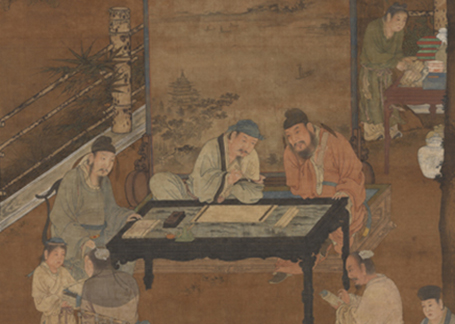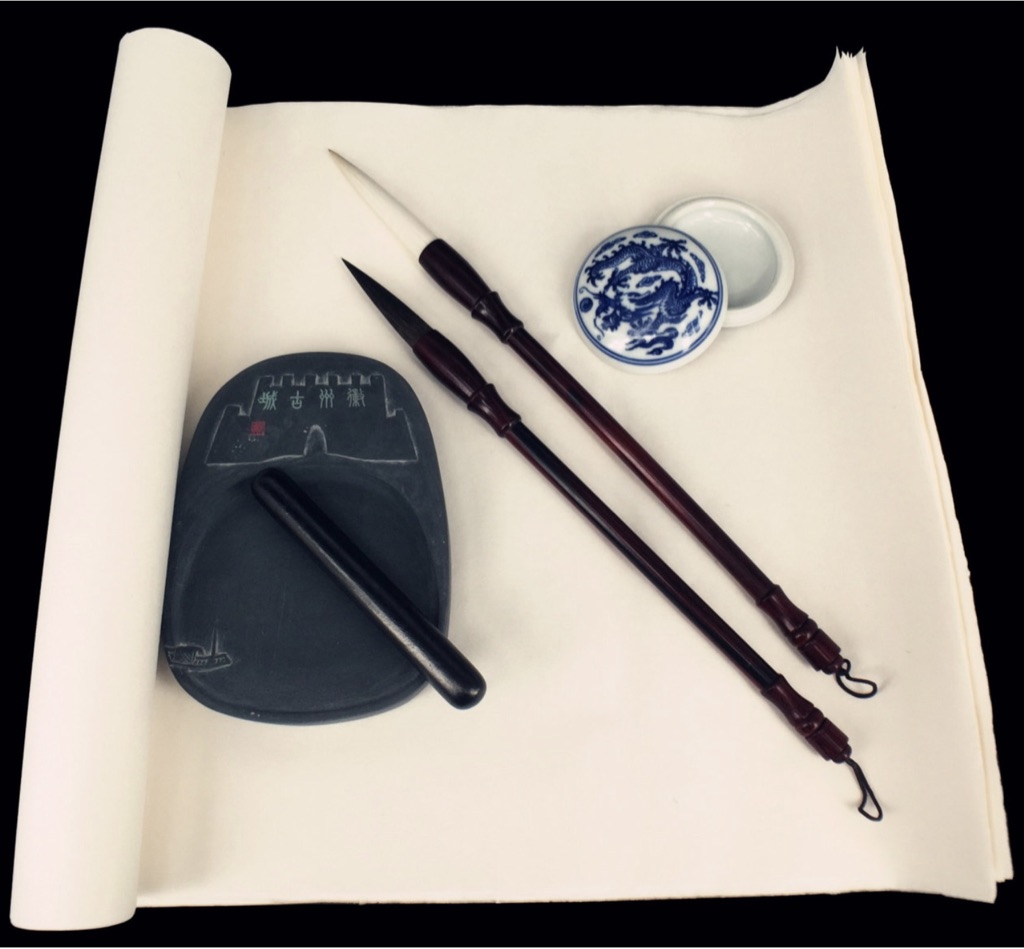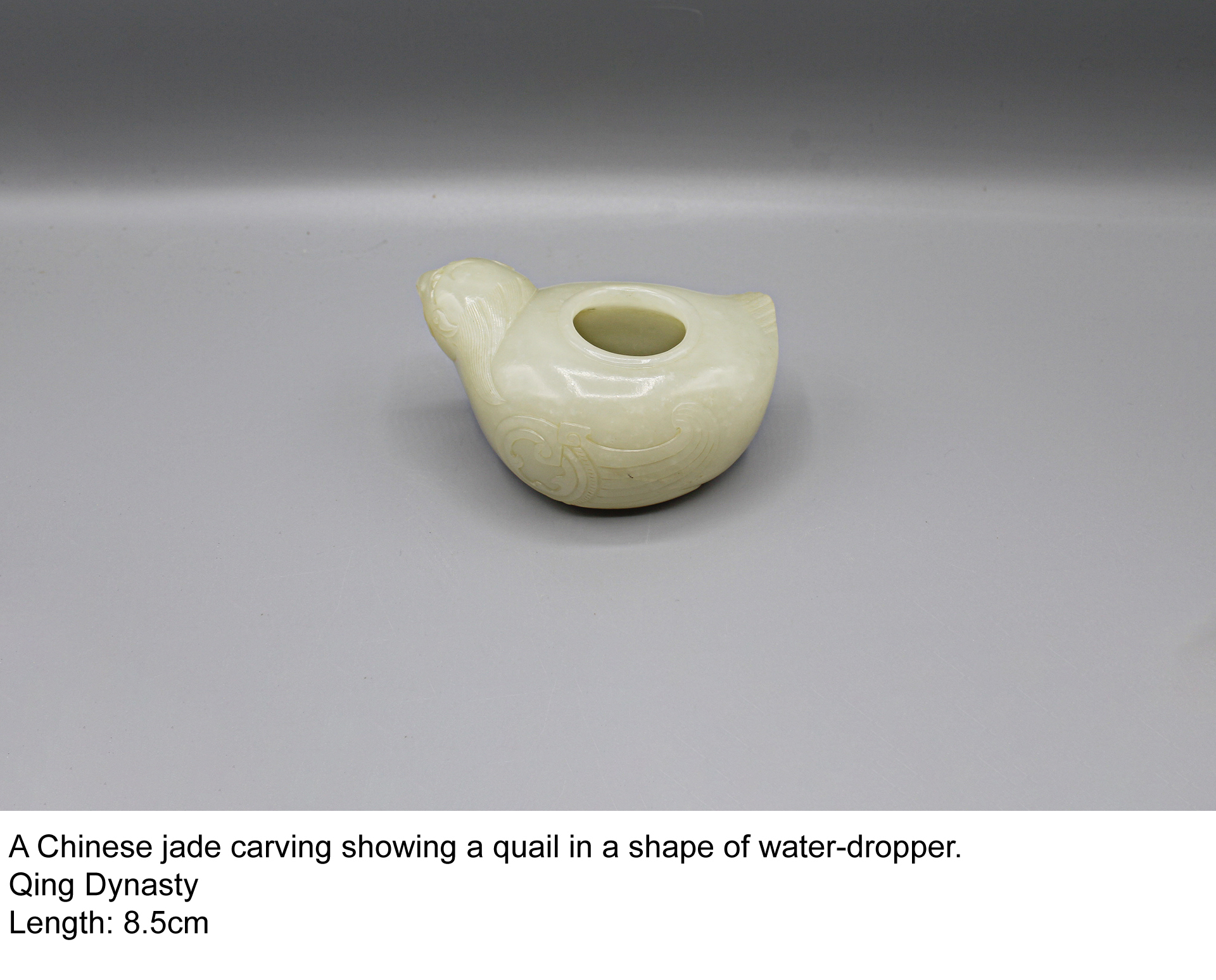In one of our previous blogs titled “The Scholar’s Studio”, we introduced how Chinese Scholars traditionally use different objects on their desk to demonstrate their high-quality skills.
The “Four Treasures” which includes inkstick, inkstand, brush and paper are very well known, however other finely carved objects are also expressing the delicate Chinese literati sensibilities.
This blog will introduce water-droppers made in different materials. The water-dropper is an essential utensil for Scholars. Although it is not selected as one of the main objects in “The Four Treasures”, it is associated with them in a vital and functional way. Each time the Scholar composed a literati work, he needed to produce ink by grinding an in-cake on an ink-stone, adding a small amount of water during the process.
In the past Chinese Scholars preferred using inkstick in the form of solidified ink to be dissolved with a small amount of water on an inkstone, in order to control the amount of water applied, they use water-dropper. A classic water-dropper has two openings which function is to allow air passing through the dropper inside, it also permits to the water to flow smoothly. A literati would raise their index finger from one hole in order to release the air for the purpose of allowing water to fall out slowly and rhythmically, it is also a way that is considered to achieve inner peace.
Various shapes and different materials were used for water-droppers to enlighten the Scholars literati achievements.
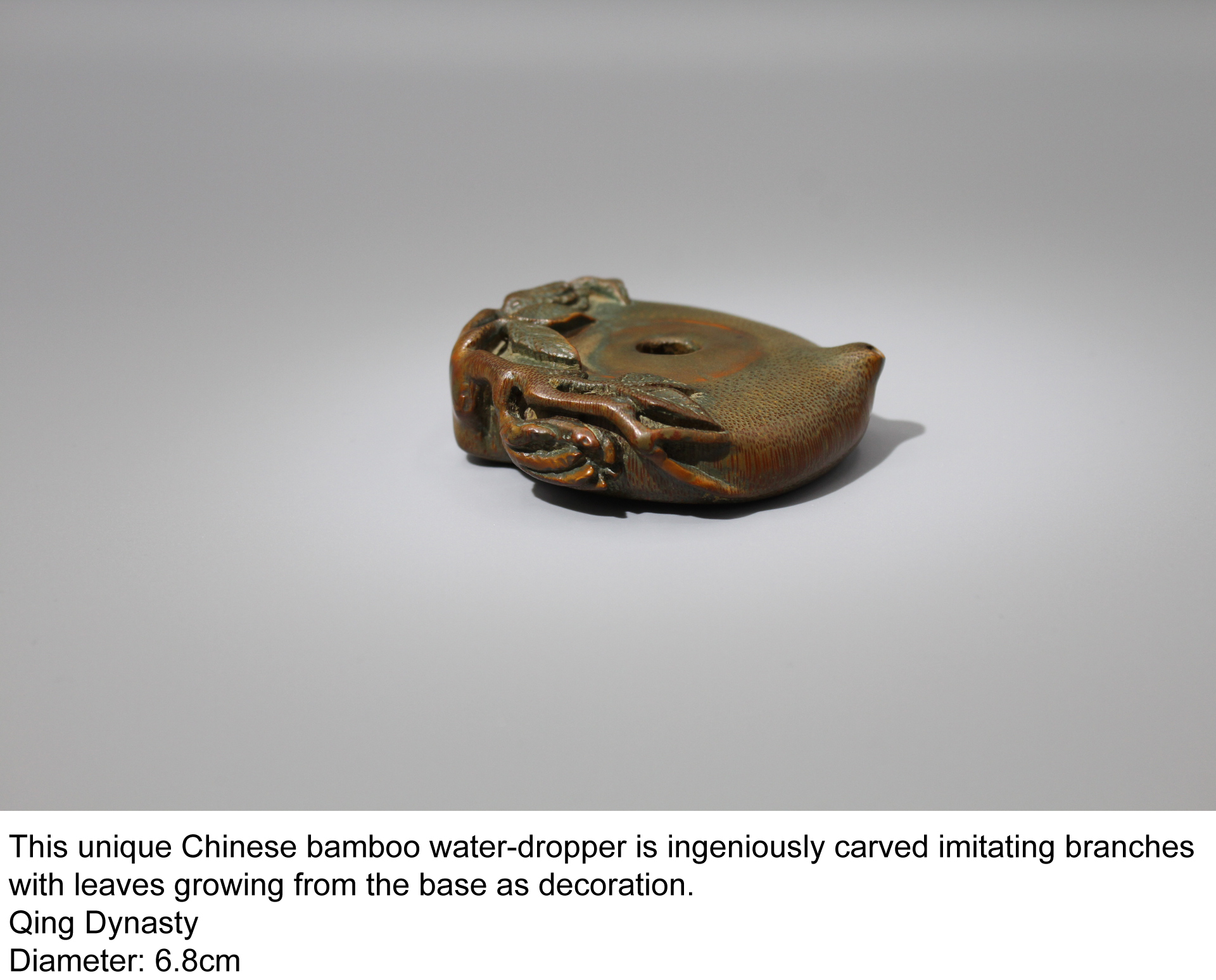 On the left you can see a very interesting piece carved in bamboo in the shape of an auspicious emblem, the peach. This unique bamboo water-dropper is ingeniously carved with leaves around the fruit.
On the left you can see a very interesting piece carved in bamboo in the shape of an auspicious emblem, the peach. This unique bamboo water-dropper is ingeniously carved with leaves around the fruit.
Along with the aesthetic consideration, this water-dropper deeply shows the essence of humble literati lifestyle and culture.
You can also find some water-dropper cast in bronze which is also a popular material in the Chinese literati heritage; bronze casting technology in China has a very long history, which dates back to the early Shang, in the mid-second millennium BC. Due to its well-established casting techniques in China, bronze has been made into various lively and delicate ornaments for Scholar’s desk. The heaviness of those bronzes could also be used as paper weight.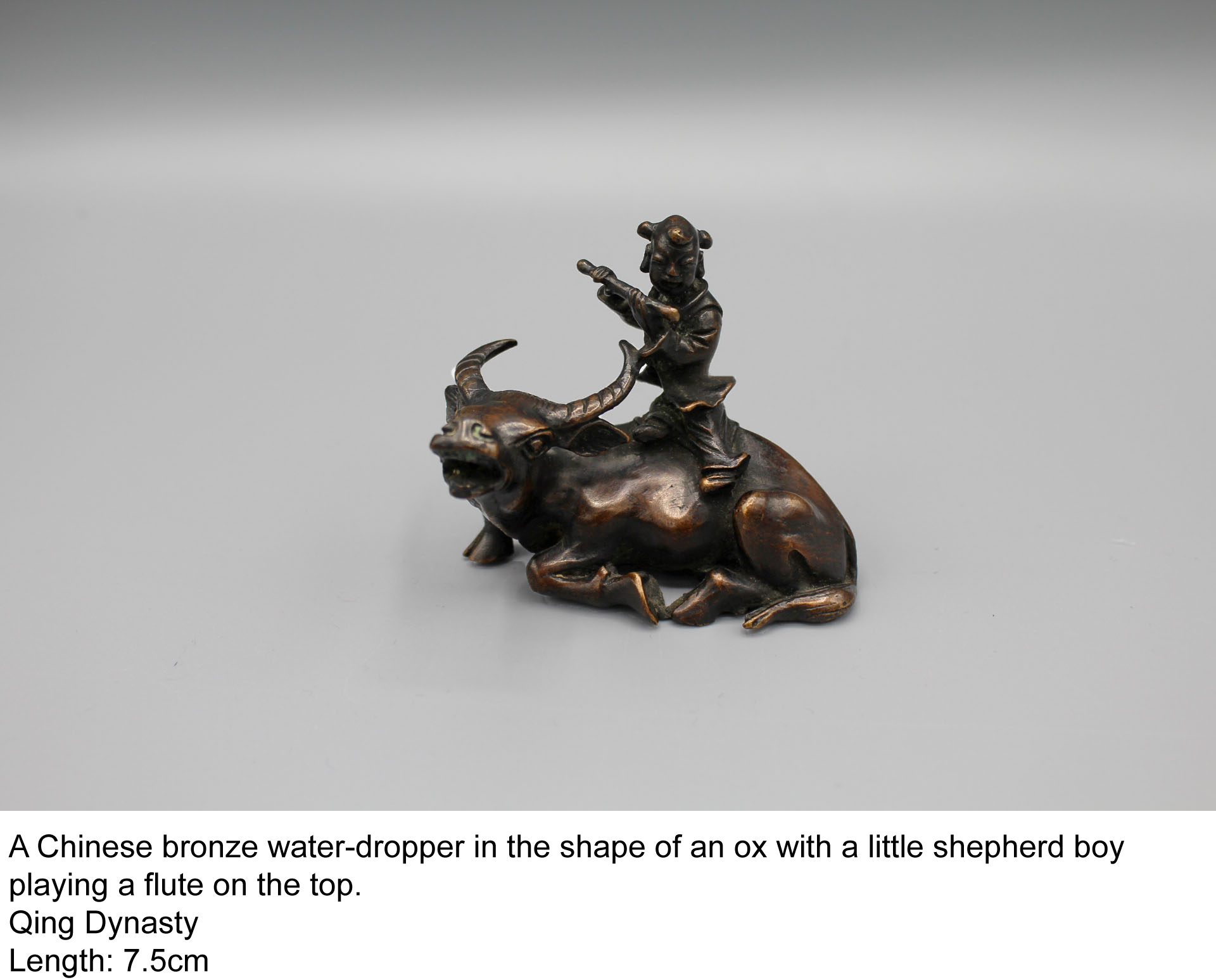
In our collection we have a piece depicting a buffalo with a shepherd boy playing the flute sitting on the top, which is a motif derived from a legend about the Emperor Hongwu founder of the Ming Dynasty. It is said he presented a picture of a boy ridding a buffalo for himself who had humble origins.
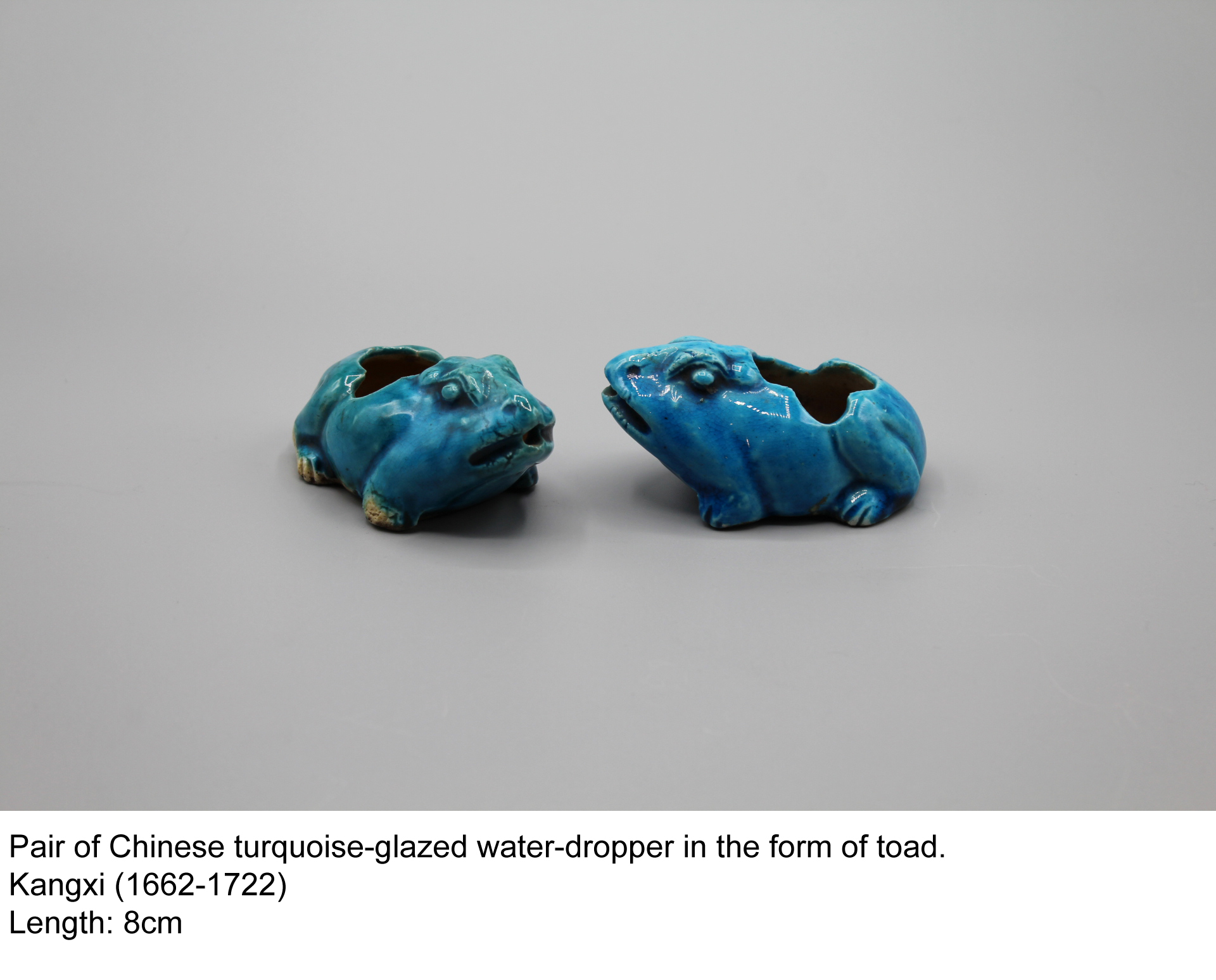 Ceramic is also a material very popular in Chinese cultural heritage, we are showing a pair of turquoise glazed water-dropper in the form of toads. Turquoise glazed technique was used since the Yuan Dynasty (1279-1368), it represented a new orientation for the potters, and was mainly used during the Ming and Qing Dynasties.
Ceramic is also a material very popular in Chinese cultural heritage, we are showing a pair of turquoise glazed water-dropper in the form of toads. Turquoise glazed technique was used since the Yuan Dynasty (1279-1368), it represented a new orientation for the potters, and was mainly used during the Ming and Qing Dynasties.
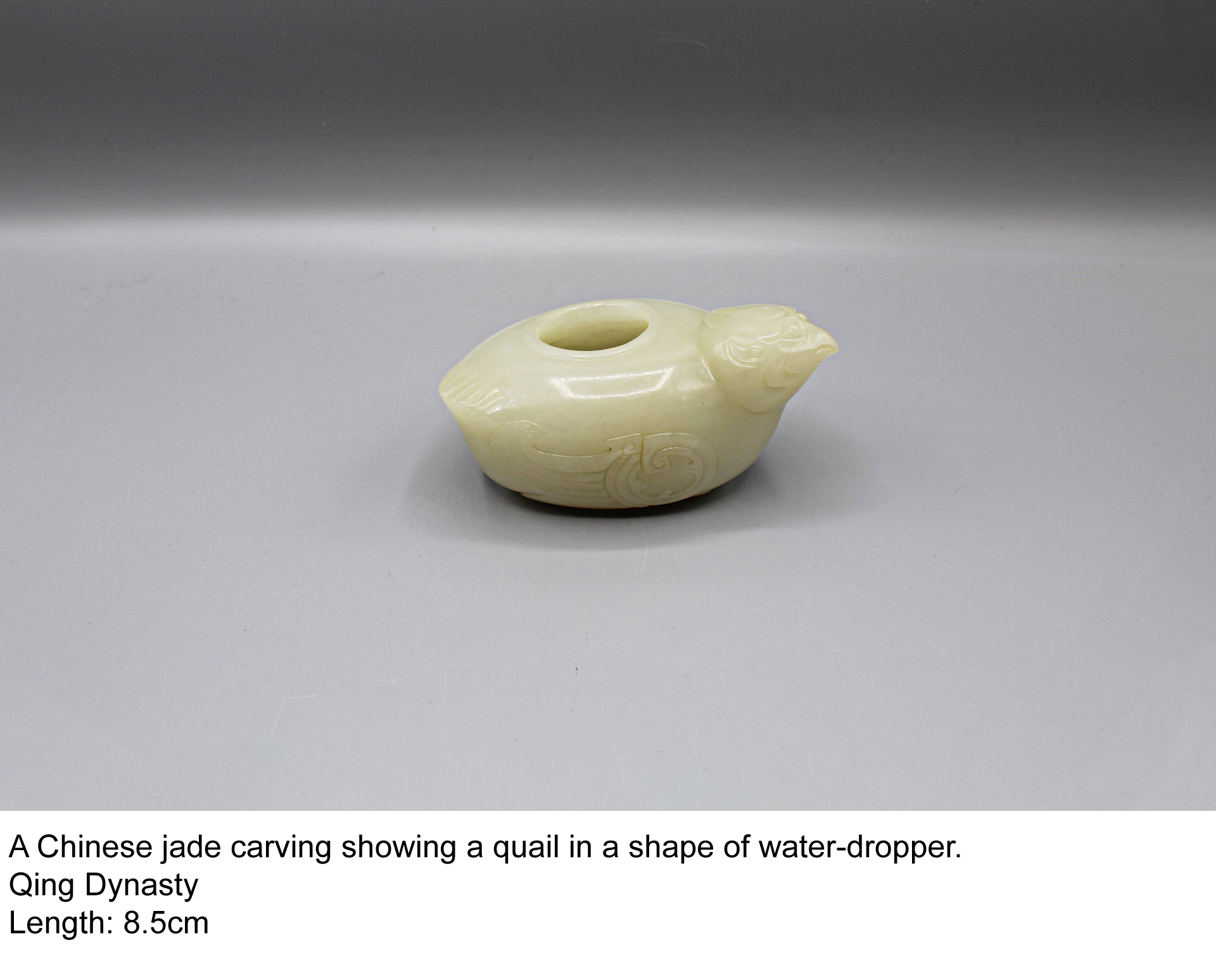 Chinese Scholars liked to use writing accessories made of Jade, as Confucius praised jade as “the embodiment of virtue”. There are hundreds of Chinese saying which use the word Jade, almost always in a positive context, as something good, noble, beautiful or honest, reinforcing the cultural belief that jade is something associated with the best in a man. We are showing a Jade water-dropper in a shape of a quail, the meaning of that bird is courage, peace and harmony depicting perfectly Chinese Scholars.
Chinese Scholars liked to use writing accessories made of Jade, as Confucius praised jade as “the embodiment of virtue”. There are hundreds of Chinese saying which use the word Jade, almost always in a positive context, as something good, noble, beautiful or honest, reinforcing the cultural belief that jade is something associated with the best in a man. We are showing a Jade water-dropper in a shape of a quail, the meaning of that bird is courage, peace and harmony depicting perfectly Chinese Scholars.
在我們之前發表的名為《文人墨寶》的文章中,我們介紹了中國文人如何以傳統的方式通過桌上的物件展現他們高品質的審美。中國的“文房四寶”, 包括硯,硯台,毛筆和紙張,它們以被人所熟知,然而其他在書桌上出現的精緻物件同樣表達了中國文人的細膩情感。此文將要展示的是不同物件製作的名為水滴壺的物件。
水滴壺是文人墨客書桌上最基本的用具之一。儘管它沒有被選進“文房四寶”中,但它以一種重要和使用的方式將它們聯繫起來。中國文人在每次創作文墨時,都會有一步在硯台上磨墨的過程,通過加入少量的水。因為在過去,中國文人喜歡使用凝固的墨水,也就是硯,在硯台上用少量的水去溶解成墨汁,他們選擇了水滴壺來實現控制用水量。
一個經典的水滴壺造型,具有兩個孔,其功能正是讓空氣順利通過滴管內部再釋放。它同樣也允許了水順利地流動。文人會從一個洞口舉起他們的食指,以釋放空氣,讓水緩慢而有節奏地落下,這也是一種被認為可以實現內心平靜的方式。各種形狀和不同材質的水滴壺被用於豐富學者們的文藝成就。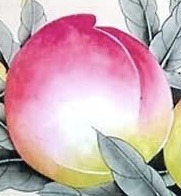
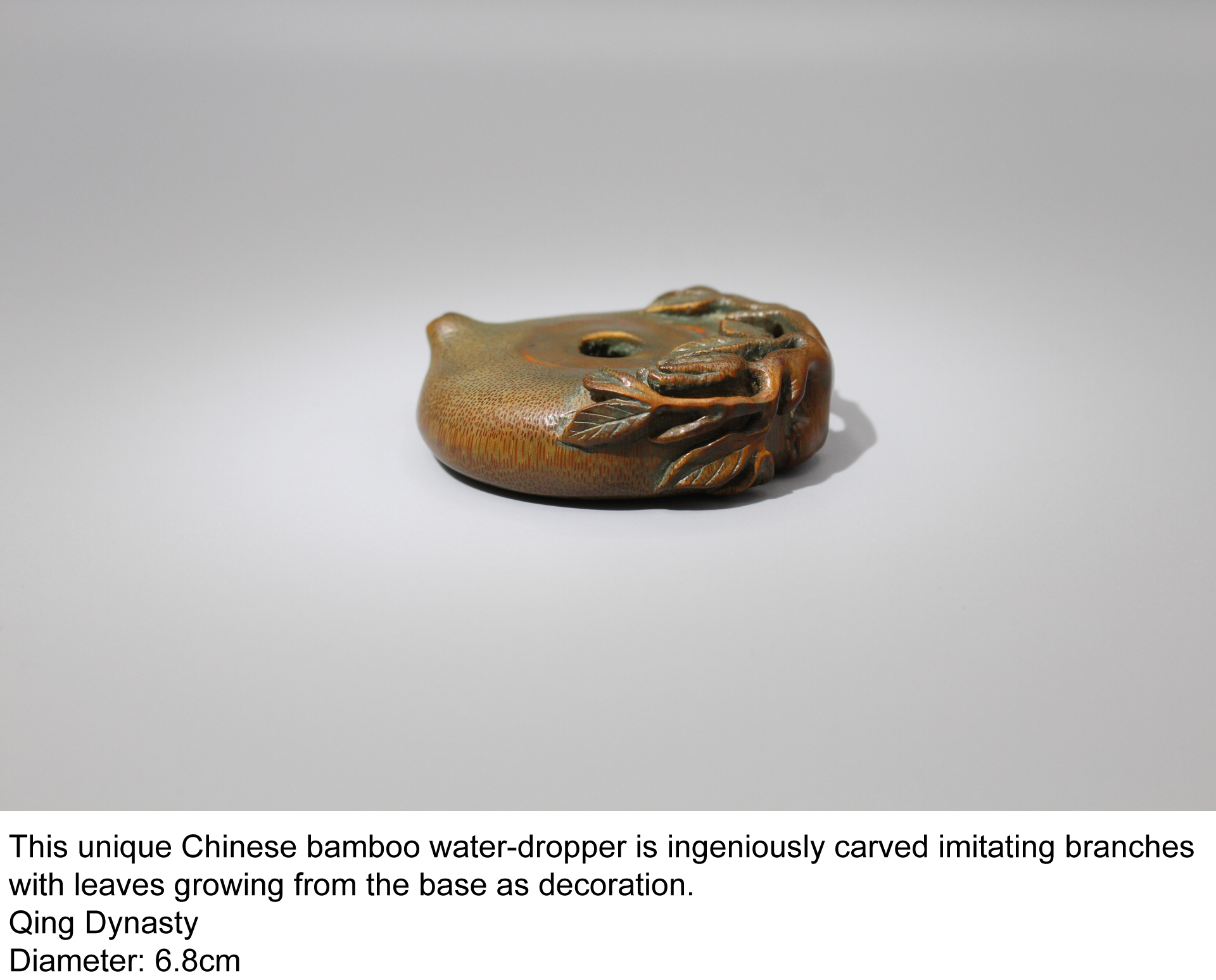 下面你可以看到一件非常有趣的竹刻作品。它的形狀是一個具有吉祥含義的圖案——桃子。這個獨特的竹質水滴壺巧妙地在果實周圍雕刻了葉子。
下面你可以看到一件非常有趣的竹刻作品。它的形狀是一個具有吉祥含義的圖案——桃子。這個獨特的竹質水滴壺巧妙地在果實周圍雕刻了葉子。
除了在美學上的考慮,這個水滴壺還深深地展示了謙遜的文人的生活方式和他們的文化精髓。
除此之外,你也可以找到一些用青銅鑄造的水滴壺,這也是中國文人遺產中的一種常見的材料,中國的青銅鑄造技術有著悠久的歷史,這可以追溯到公元前兩千年的商朝早期。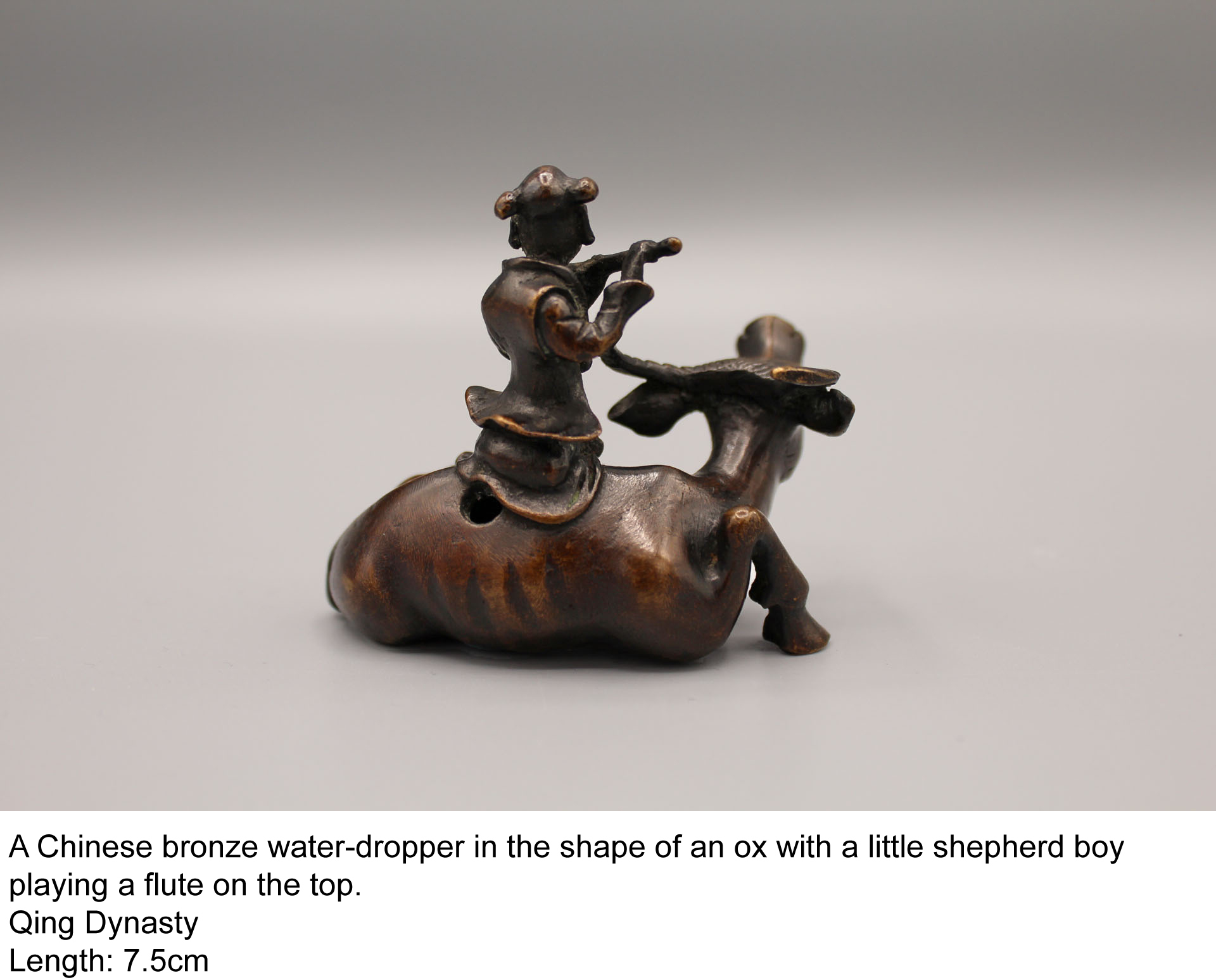
由於中國具備了完善的鑄造技術,青銅也被製作成各種活潑精緻的文房飾品。並且,由於這些青銅器不小的重量,它們也可以作為紙鎮使用。
在我們的收藏中,有一件青銅製水滴壺作品描繪了一頭水牛,上面坐著一個吹笛子的牧童,這一形象也是源自明朝洪武皇帝的傳說。據說他將騎水牛的男孩形象以代表他純樸和謙卑的出身。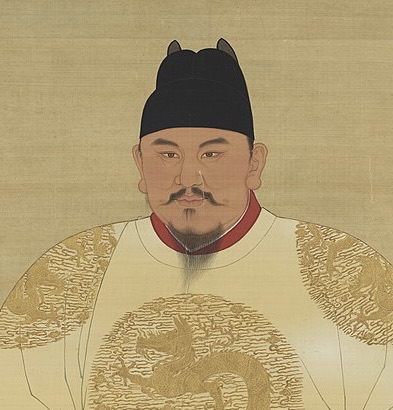
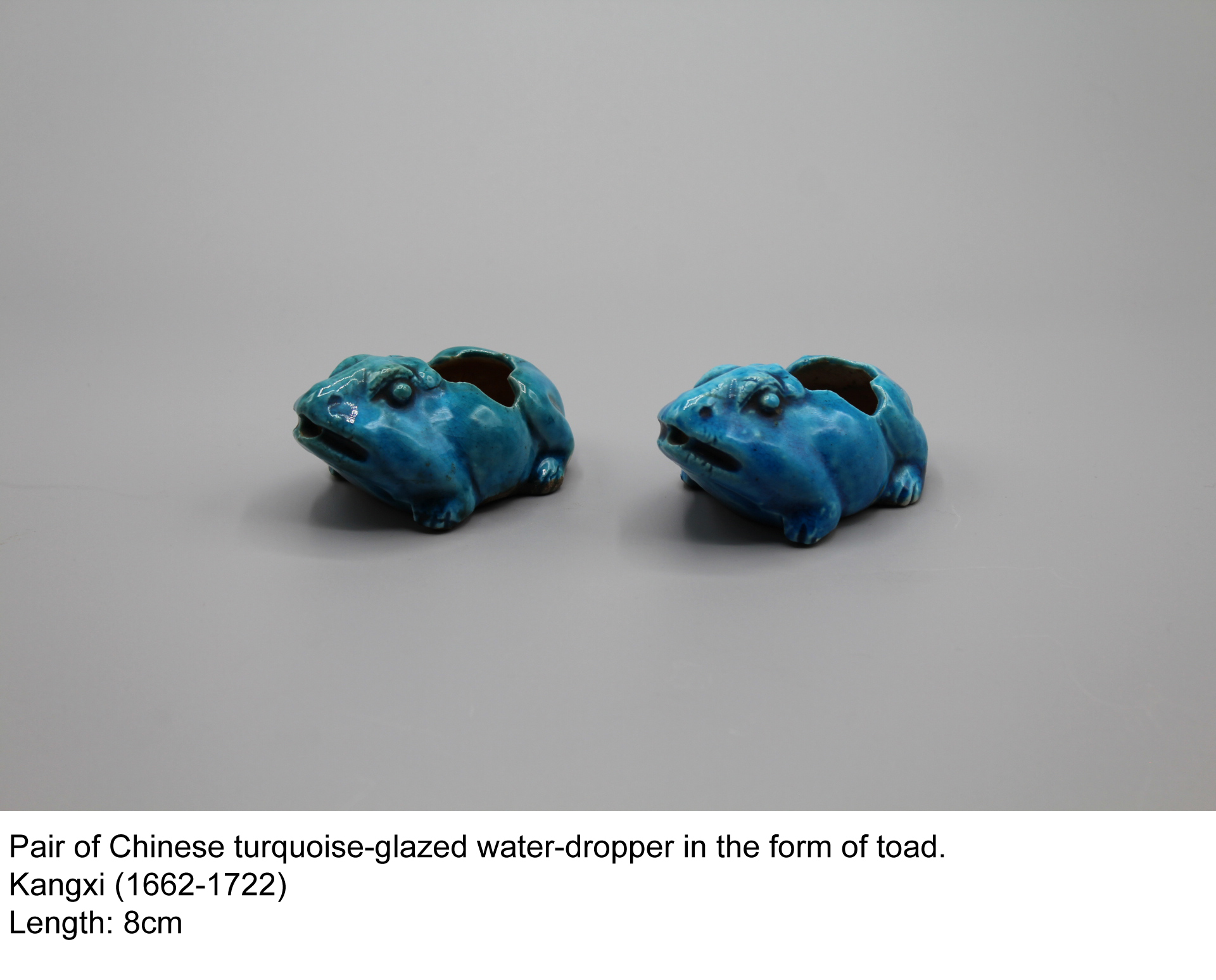 陶瓷也是中國文化遺產中非常流行的一種材料,我們展示的是一對綠松石釉面的蟾蜍造型的水滴壺。
陶瓷也是中國文化遺產中非常流行的一種材料,我們展示的是一對綠松石釉面的蟾蜍造型的水滴壺。
綠松石釉面技術源自元朝(1279-1368),它在當時呈現出此後陶藝家們的新風潮,隨後在明清時期被廣泛地使用。
中國文人喜歡使用玉石製成的書寫配件,因為孔子將其讚為“美德的化身”。中國有許多使用玉這個詞的諺語,幾乎都是讚美之詞,通常指美好的,高貴的,美麗的或者誠實的事物,加深了其文化信仰,即玉和人的美德相互輝映的寓意。

